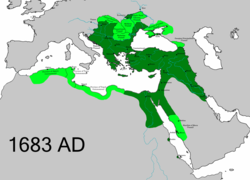This is a timeline of major events in the history of Jerusalem; a city that has been fought over sixteen times over millennia. [1] During its history, Jerusalem has been destroyed twice, besieged 23 times, attacked 52 times, and captured and recaptured 44 times. [2]
Contents
- Chalcolithic
- Bronze Age: Canaanite city
- Iron Age
- Independent Israelite capital
- Neo-Assyrian and Neo-Babylonian period
- Persian (Achaemenid) period
- Hellenistic period
- Under Alexander, the Ptolemies, and Seleucids
- Hasmonean kingdom
- Classical/Polytheistic Roman period
- Early Roman period
- Late Roman period (Aelia Capitolina)
- Byzantine/Christian Roman period
- Early Muslim period
- Rashidun, Umayyad and Abbasid Caliphates
- Fatimid and Seljuk rule
- Crusader/Ayyubid period
- First Crusader Kingdom of Jerusalem (1099–1187)
- Ayyubids and Second Crusader Kingdom
- Mamluk period
- Ottoman period
- Early Ottoman period
- Late Ottoman period
- British Mandate
- After 1948
- Partition into West (Israel) and East (Jordan)
- Reunification after 1967
- Graphical overview of Jerusalem's historical periods
- See also
- References
- Notes
- Bibliography
- External links































